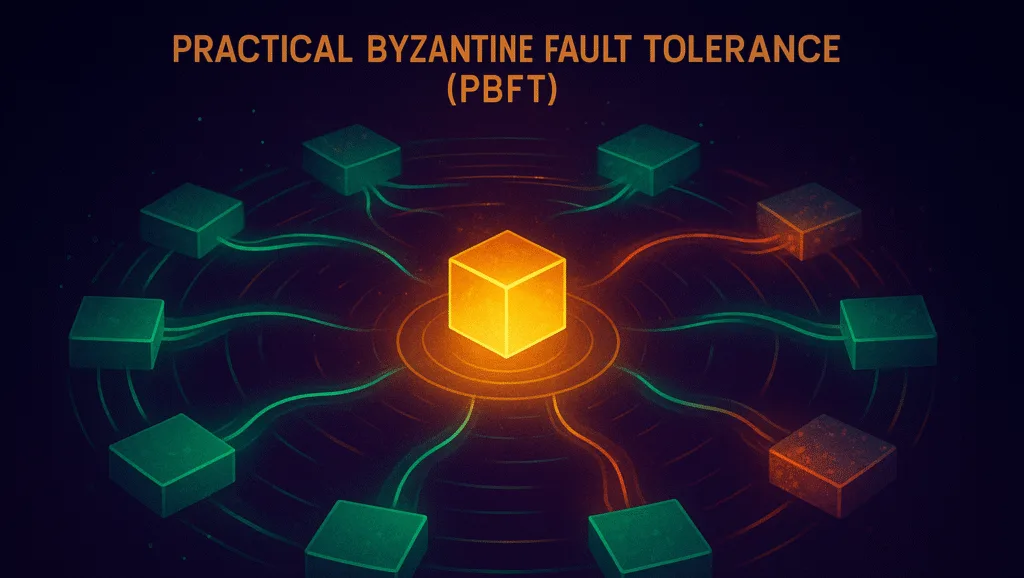Every blockchain needs a way for its participants to agree on what’s true. That’s what consensus mechanisms are for. Among the many approaches out there, Practical Byzantine Fault Tolerance (PBFT) stands out as one designed for reliability in environments where some participants might fail or act maliciously.
Let’s break down what PBFT is, how it works, where it’s used, and why it matters in the bigger picture of blockchain technology!
What is PBFT?
PBFT is a consensus algorithm developed in the late 1990s by Miguel Castro and Barbara Liskov. It was built to solve what computer scientists call the Byzantine Generals Problem, the challenge of reaching agreement in a distributed system even when some nodes can’t be trusted.
In simple terms, PBFT allows a network to keep running smoothly even if some participants are dishonest, faulty, or trying to disrupt the process. The “practical” part of PBFT means it’s optimized for real-world performance, not just theory!
How does PBFT work?
PBFT relies on a structured communication process between nodes. Here’s the flow:
- Request – A client submits a transaction request to the network.
- Pre-prepare phase – A primary node (sometimes called the leader) proposes the order of the transaction.
- Prepare phase – The other nodes (replicas) broadcast messages confirming they agree with the proposal.
- Commit phase – Nodes exchange another round of messages to ensure everyone’s aligned.
- Execution – Once consensus is reached, the transaction is executed and added to the ledger.
PBFT can tolerate up to one-third of nodes being faulty or malicious. That’s its key strength: as long as two-thirds are honest, the system reaches consensus.

Why PBFT matters?
Here’s why PBFT is important in blockchain and beyond:
- Fault tolerance: The network continues to function even with dishonest nodes.
- Finality: Once a block is confirmed, it’s final; there’s no risk of forks like in Proof of Work.
- Efficiency: No energy-hungry mining is required, making it faster and more eco-friendly than PoW.
- Enterprise use: PBFT fits private or permissioned blockchains where participants are known but may not always be reliable.
Pros and Cons of PBFT
| Pros | Cons |
| Strong security guarantees against faulty or malicious actors. | As the number of nodes grows, communication overhead increases sharply. |
| Quick confirmation times compared to Proof of Work. | Works best in permissioned systems with limited participants. |
| Works well for smaller, controlled networks. | Performance can dip if the primary node misbehaves. |
| No reliance on expensive hardware or massive energy use. | Requires multiple rounds of messaging for each block. |
PBFT compared to other consensus mechanisms
Here’s a snapshot of how PBFT stacks up:
| Mechanism | Strengths | Weaknesses | Best Use Cases |
|---|---|---|---|
| Proof of Work (PoW) | Very secure, decentralized | Energy-intensive, slow | Public blockchains (Bitcoin) |
| Proof of Stake (PoS) | Energy efficient, scalable | Risk of wealth concentration | Public blockchains (Ethereum, Cardano) |
| Delegated PoS (DPoS) | Fast, community voting | Centralization risk | High-throughput networks (EOS, TRON) |
| Proof of Authority (PoA) | Efficient, low-latency | Limited decentralization | Enterprise/consortium chains |
| PBFT | Fault-tolerant, fast finality | Poor scalability with large networks | Permissioned blockchains (Hyperledger, Cosmos SDK-based systems) |
Also Read: Proof of Work (PoW) vs Proof of Stake (PoS)
Blockchains and projects using PBFT
PBFT and its variations are widely used in enterprise and permissioned blockchains. Some notable examples:
- Hyperledger Fabric – A leading enterprise blockchain framework.
- Tendermint (Cosmos) – Uses a variant of PBFT for fast consensus in the Cosmos ecosystem.
- Zilliqa – Early versions incorporated PBFT-based consensus for scalability.
- NEO – Uses a delegated Byzantine Fault Tolerance (dBFT), an evolution of PBFT.
Frequently Asked Questions
PBFT can tolerate up to one-third of nodes being faulty or malicious while still reaching consensus.
Not really. Its communication overhead makes it better for smaller, permissioned networks rather than massive, open systems like Bitcoin.
Delegated BFT (dBFT), used by NEO, is a modified version where token holders elect delegates to participate in consensus, improving scalability.
Because once consensus is reached in PBFT, the decision is final. There are no forks or chances of reorganizations like in Proof of Work systems.
Practical Byzantine Fault Tolerance is a powerful consensus model that shines in private and enterprise blockchains. It solves the Byzantine Generals Problem in a way that works under real-world conditions, offering security, speed, and fault tolerance.
That said, it’s not a universal solution. PBFT struggles to scale across thousands of nodes, which limits its use in public blockchains. But for consortia, enterprises, and ecosystems like Cosmos, it’s one of the most reliable consensus choices available today.
The big picture: PBFT proves that consensus doesn’t have to be one-size-fits-all. It shows how different blockchain models can balance trust, speed, and security depending on what the network needs most!
With over five years of experience in the tech industry, Kazim excels at simplifying complex topics, making them accessible to tech enthusiasts and general readers alike.
He has contributed to several renowned publications worldwide, including WindowsReport and Allthings.how, bringing insightful coverage of key developments in the field.
When he’s not writing, you’ll find Kazim planning weekend getaways or diving into tech verticals beyond his expertise.




